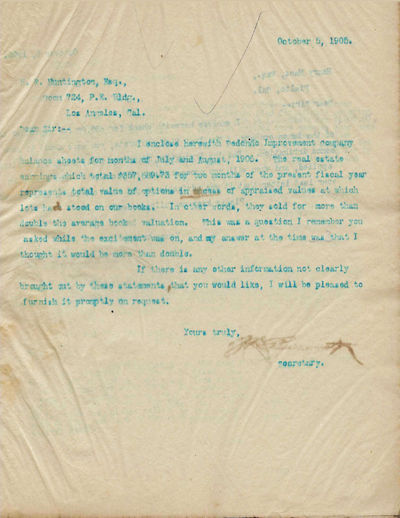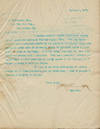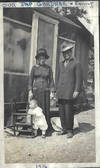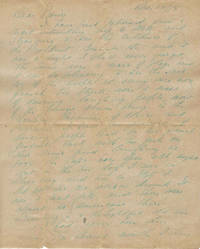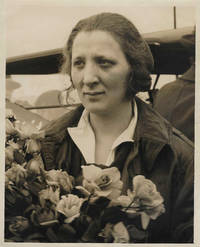by Ainsworth, Harry B.,
Archive consists of 804 retained copies of outgoing letters, 1013 manuscript and typescript pages, (in two letter copy books and files of typescript carbons), three photograph albums, containing 160 photographs, documenting two of the family's mansions, in Los Angeles and Los Altos Hills, and their ranch in Arcadia, California, plus several related ephemeral items, newspaper clippings, et cetera.
Archive dealing with southern California real estate development in the early twentieth century, particularly, the founding and development of the city of Redondo Beach. The archive consists of retained copies of outgoing correspondence of Harry Babbitt Ainsworth (1871-1925) pertaining to his management of the various family companies that controlled the city of Redondo Beach, Los Angeles County, California. The town was founded by Ainsworth's father John Commigers Ainsworth and his business partner, R. R. Thompson. The archive also includes Ainsworth family photograph albums. The materials date from 1897-1958.
The correspondence deals with all aspects of the development of Redondo Beach. The Ainsworth family owned and controlled the entire town, the Redondo Hotel, the Redondo Improvement Company and the Redondo Railway. The letters discuss the buying and selling of lots in the town, construction of buildings, wharves, a golf course and country club, and the construction and extension of the Redondo Railway connecting Los Angeles with Redondo Beach.
H. B. Ainsworth took over the management of the Redondo Companies after the deaths of his father and older brother, G. J. Ainsworth. Ainsworth sold all of the family's Redondo holdings to Henry E. Huntington in 1905. The letters include correspondence dealing with the immediate aftermath of the Huntington sale, financial aspects of the deal, and the resulting real estate boom in Redondo Beach after Huntington's purchase. Huntington went on to develop the town further and he also introduced surfing to California in Redondo.
The Ainsworth family also had extensive real estate holdings in Oregon, Washington, in Oakland and San Francsico, and as far east as Chicago. Ainsworth was also active in a company named The California Wine Association. The family also owned several banks in Portland, Oregon and elsewhere. The collection also contains correspondence commenting of the aftereffects of the disastrous 1906 San Francisco earthquake and its effects on California.
Redondo Beach California was founded by Captain John C. Ainsworth and Captain R. R. Thompson, pioneer steamboat Captains from Oregon. Ainsworth was born June 6, 1822, in Springboro, Warren County, Ohio. His father died when he was about seven years old and Ainsworth began to support himself. He worked on the Mississippi River and soon became a master on a passenger steamer sailing between St. Louis and upriver points. At the time of the discovery of gold in California he traveled there in company with William C. Ralston, who became one of the distinguished bankers and financiers of the west. Ralston remained in San Francisco where he became one of the pioneer bankers of the city, while Ainsworth went to Oregon to take command of the Lot Whitcomb the first steamer that ran on the Willamette and Columbia rivers. Ainsworth became the President of the Oregon Steamship & Navigation Company until it was merged with the Oregon Railroad & Navigation Company. Ainsworth remained president of the latter until 1881, when it was sold to the Villard Syndicate for five million dollars. He was next instrumental in building the Missouri Pacific Railroad from California from California to the south. In 1881 he erected the Ainsworth building in Portland, at the corner of Oak and Third Streets, and at about the same time established the Central Bank of Oakland California, of which he remained the president until his death. In 1883 he organized the Ainsworth National Bank of Portland.
Captain Ainsworth was a large investor in Tacoma real estate and was prominently identified with the construction of the Northern Pacific Railroad Company between the Columbia River and Puget Sound. Following his removal to California in 1880, he became interested in local banking and other business enterprises in the state. He financed the project that turned Redondo Beach into one of the finest seaside resorts on the Pacific Coast.
In 1887, Captain Ainsworth and Robert R. Thompson purchased a large acreage of the old Sansal Redondo Rancho and founded the town of Redondo Beach. They laid the city out in blocks and named the north-south streets after Spanish women and the east-west streets after precious stones. They built a wharf and other facilities, with the hope that it might become the principal port of Los Angeles. The two partners also constructed the once famous Redondo Hotel and a railroad connecting it with Los Angeles. The English themed 225 room hotel was finished in 1890, whose sister was the Hotel Coronado. It had lavish amenities for its time, such as a bathroom on every floor, steam heat, landscaped gardens, a ballroom, an 18-hole golf course, and tennis courts on the beach.
Ainsworth's son George Jennings Ainsworth became one of the principal backers of the Redondo Railway – incorporated in 1889. He became the local manager of the Redondo Hotel as well as of all the other Redondo Companies. Harry Babbit Ainsworth, of Los Angeles, Captain Ainsworth's son from his third marriage, seems to have taken over management of the Ainsworth's business affairs after the death of G.J. Ainsworth in 1895, these interests included the Redondo Improvement Company, and the Redondo Company of Chicago. The Ainsworth's had extensive real estate investments not only in California, Oregon, and Washington, but as far east as Chicago.
Redondo Beach grew slowly in the years after Ainsworth and Thompson laid out the town. In 1905 Henry Huntington announced his intention to purchase the Redondo Improvement Company, which owned most of Redondo Beach. Huntington had already gained control of the Redondo Railway, which operated two lines from Los Angeles. "The magic name of Huntington," as the Los Angeles Times put it, emboldened speculators and triggered a 2-week real-estate frenzy.
Agents set up more than 100 real-estate offices, some in tents, on Front Street. As a result of the boom Huntington sold about three million dollars' worth of Redondo Beach property. Huntington invested heavily in Redondo Beach and encouraged its long-term development. In 1907 he constructed a 3-story pavilion with a ballroom, restaurant, and theater at Coral Way and Midway. In 1909 he opened the Plunge, advertised as the largest indoor saltwater plunge in the world. It had three heated pools, steam and Turkish baths, and more than 1,000 dressing rooms. The complex could hold 2,000 bathers at time. For 30 years, the Plunge was a major West Coast attraction.
To lure the public to Redondo, Huntington hired George Freeth, now considered the father of modern-day surfing, to exhibit the sport to crowds gathered on the shore.
Captain Ainsworth was married three times; his first wife died six moths after their marriage. His second wife was Jane White, a daughter of Judge S. S. White, an Oregon pioneer of 1845, who settled in Oregon City. The couple had a son George Jennings Ainsworth (1852-1895), who later became his partner in the development of Redondo Beach. Jane Ainsworth died in 1863. He was then married in San Francisco to Fanny Babbitt, daughter of General Edwin Babbitt. The couple had six children, J.C. Ainsworth, of Portland, Harry Babbitt Ainsworth of Redondo Beach and Los Angeles, Laura Ainsworth, Daisy Ainsworth, Maud Ainsworth, and Belle Ainsworth.
Redondo Beach grew rapidly around Huntington's splashy attractions, more than quintupling in population from 855 in 1900 to 4,900 in 1920.
Collection Inventory:
Correspondence:
Ainsworth, Harry Babbitt, Manuscript Letter Copybook, 1895-1896
Quarto, 117 letters, 228 pages, letters copied in ink and occasional typescript, on thin tissue paper, bound in contemporary cloth, back strip and rear board missing, text in generally good clean condition, some typescript letters faded and illegible, not included in count above, else very good.
Ainsworth, Harry Babbitt, Manuscript Letter Copy Book, 1905-1906
Quarto, 402 letters, 517 pages, 17-page name index, mainly typescript, on thin tissue paper, bound in contemporary cloth, back strip missing, some wrinkling to several pages, otherwise in good legible condition. Covers the period immediately after Huntington's purchase of the Redondo properties, and the San Francisco earthquake of 1906.
Ainsworth, Harry Babbitt, File of Typescript Carbons of Outgoing Correspondence, 1907
171 letters, 197 pages
Ainsworth, Harry Babbitt, File of Typescript Carbons of Outgoing Correspondence, January – June, 1908
50 letters, 57 pages
Ainsworth, John C., File of Five Letters to his brother H. B. Ainsworth, March 1897
5 letters, 7 pages, (plus one incomplete letter).
Ainsworth, Miscellaneous Correspondence, 1910, 1933
2 letters, 7 pages
Manuscript Ainsworth Family Guest Book, 1909-1931
Oblong 12mo, 139 pages, binding worn, lacking rear cover.
Photograph Albums
Photograph Album Depicting Interior and Exterior Views of the Residence of Harry Babbitt Ainsworth, 2190 West Adams St., Los Angeles, California
Oblong Quarto, nd circa 1920, containing 18 silver prints, measuring 6 ½ x 81 ½ inches, mounted on brown paper wrappers, black string tie, wrappers worn and dogeared, front wrapper detached but present, image mounted to front wrap now missing, rear wrapper no longer present. Images are generally in good condition, two somewhat faded. A later Ainsworth family member has captioned the photographs in ball point pen.
The images include interior and exterior views of the sizable Los Angeles residence of Harry Babbitt Ainsworth. There are also several views of the grounds and garden surrounding the home. The residence is no longer standing.
Photograph Album Depicting Interior and Exterior Views of Lantarnam Hall, Los Altos, California, with Images of the Morgan-Ainsworth Family, circa 1915-1918
Oblong folio, containing 57 mounted photographic images of Lantarnam Hall, with 14 images inserted in the leaves, they measure between 6 x 7 ¾ and 7 x 10 inches, images mounted on black paper leaves, captioned in ink, lacking covers, images are in very good clean condition.
There are interior and exterior views of the home, its furnishings and artwork, including Italian Renaissance paintings and sculpture, and furniture, as well as architectural elements removed from Tudor structures in England and utilized in Lantarnam Hall.
Lantarnam Hall is a historic mansion in Los Altos Hills, California, built in 1914-1916 for Percy Morgan, a director of Wells Fargo and a trustee of Stanford University. The house was designed by architect John H. Powers in the Tudor Revival Style. It has been listed on the National Register of Historic Places since 1985. It is still extant but has been repurposed as a school. The album also includes images of the Morgan family.
The house was built by Percy Tredegar Morgan who immigrated to the United States from Britain in 1862. He worked for various mining companies in Nevada, and Montana as an accountant and later as superintendent. He then went to San Francisco where he made a fortune and became a director of Wells Fargo. In 1894, he married Daisy Babbitt Ainsworth, the sister of Harry Babbitt Ainsworth. The couple had two sons, Percy Tredegar Morgan Jr., born 1897, and John Ainsworth Morgan born in 1899.
Photograph Album Depicting Snapshot Views of the Ainsworth Family Ranch in Arcadia, California, circa 1908-1958
72 photographs mounted in a modern photograph album, many of the images appear to have been excised from earlier albums and placed in this, also includes several inlaid ephemeral items and news paper clippings.
The images depict Ainsworth family members through the years at their ranch in Arcadia, Los Angeles County, California. The images also show exterior views of the ranch house, outbuildings, gardens and orange groves. There are two images of the Japanese gardener, employed by the Ainsworth's and his family.
References:
Davidson, Ronald A., Before "Surfurbia": The Development of the South Bay Beach Cities through the 1930's
University of Hawaii Press: Yearbook of the Association of Pacific Coast Geographers, 2004, Vol. 66 (2204). https://www.jstor.org/stable/24041426
Gaston, Joseph, The Centennial History of Oregon, 1811-1912,
Chicago: Clarke Publishing Co., 1912, vol. 4, p. 6
Hoyt, Franklin, The Redondo Railroad
The Historical Society of Southern California Quarterly, June 1954, Vol. 36, No. 2, (June 1954) pp. 130-137
https://www.jstor.org/stable/41168467
Newmark, Marco R., Early California Resorts
The Historical Society of Southern California Quarterly, Vol. 35, No. 2 (June, 1953), pp. 129-152
https://www.jstor.org/stable/41168403 (Inventory #: 31255)
Archive dealing with southern California real estate development in the early twentieth century, particularly, the founding and development of the city of Redondo Beach. The archive consists of retained copies of outgoing correspondence of Harry Babbitt Ainsworth (1871-1925) pertaining to his management of the various family companies that controlled the city of Redondo Beach, Los Angeles County, California. The town was founded by Ainsworth's father John Commigers Ainsworth and his business partner, R. R. Thompson. The archive also includes Ainsworth family photograph albums. The materials date from 1897-1958.
The correspondence deals with all aspects of the development of Redondo Beach. The Ainsworth family owned and controlled the entire town, the Redondo Hotel, the Redondo Improvement Company and the Redondo Railway. The letters discuss the buying and selling of lots in the town, construction of buildings, wharves, a golf course and country club, and the construction and extension of the Redondo Railway connecting Los Angeles with Redondo Beach.
H. B. Ainsworth took over the management of the Redondo Companies after the deaths of his father and older brother, G. J. Ainsworth. Ainsworth sold all of the family's Redondo holdings to Henry E. Huntington in 1905. The letters include correspondence dealing with the immediate aftermath of the Huntington sale, financial aspects of the deal, and the resulting real estate boom in Redondo Beach after Huntington's purchase. Huntington went on to develop the town further and he also introduced surfing to California in Redondo.
The Ainsworth family also had extensive real estate holdings in Oregon, Washington, in Oakland and San Francsico, and as far east as Chicago. Ainsworth was also active in a company named The California Wine Association. The family also owned several banks in Portland, Oregon and elsewhere. The collection also contains correspondence commenting of the aftereffects of the disastrous 1906 San Francisco earthquake and its effects on California.
Redondo Beach California was founded by Captain John C. Ainsworth and Captain R. R. Thompson, pioneer steamboat Captains from Oregon. Ainsworth was born June 6, 1822, in Springboro, Warren County, Ohio. His father died when he was about seven years old and Ainsworth began to support himself. He worked on the Mississippi River and soon became a master on a passenger steamer sailing between St. Louis and upriver points. At the time of the discovery of gold in California he traveled there in company with William C. Ralston, who became one of the distinguished bankers and financiers of the west. Ralston remained in San Francisco where he became one of the pioneer bankers of the city, while Ainsworth went to Oregon to take command of the Lot Whitcomb the first steamer that ran on the Willamette and Columbia rivers. Ainsworth became the President of the Oregon Steamship & Navigation Company until it was merged with the Oregon Railroad & Navigation Company. Ainsworth remained president of the latter until 1881, when it was sold to the Villard Syndicate for five million dollars. He was next instrumental in building the Missouri Pacific Railroad from California from California to the south. In 1881 he erected the Ainsworth building in Portland, at the corner of Oak and Third Streets, and at about the same time established the Central Bank of Oakland California, of which he remained the president until his death. In 1883 he organized the Ainsworth National Bank of Portland.
Captain Ainsworth was a large investor in Tacoma real estate and was prominently identified with the construction of the Northern Pacific Railroad Company between the Columbia River and Puget Sound. Following his removal to California in 1880, he became interested in local banking and other business enterprises in the state. He financed the project that turned Redondo Beach into one of the finest seaside resorts on the Pacific Coast.
In 1887, Captain Ainsworth and Robert R. Thompson purchased a large acreage of the old Sansal Redondo Rancho and founded the town of Redondo Beach. They laid the city out in blocks and named the north-south streets after Spanish women and the east-west streets after precious stones. They built a wharf and other facilities, with the hope that it might become the principal port of Los Angeles. The two partners also constructed the once famous Redondo Hotel and a railroad connecting it with Los Angeles. The English themed 225 room hotel was finished in 1890, whose sister was the Hotel Coronado. It had lavish amenities for its time, such as a bathroom on every floor, steam heat, landscaped gardens, a ballroom, an 18-hole golf course, and tennis courts on the beach.
Ainsworth's son George Jennings Ainsworth became one of the principal backers of the Redondo Railway – incorporated in 1889. He became the local manager of the Redondo Hotel as well as of all the other Redondo Companies. Harry Babbit Ainsworth, of Los Angeles, Captain Ainsworth's son from his third marriage, seems to have taken over management of the Ainsworth's business affairs after the death of G.J. Ainsworth in 1895, these interests included the Redondo Improvement Company, and the Redondo Company of Chicago. The Ainsworth's had extensive real estate investments not only in California, Oregon, and Washington, but as far east as Chicago.
Redondo Beach grew slowly in the years after Ainsworth and Thompson laid out the town. In 1905 Henry Huntington announced his intention to purchase the Redondo Improvement Company, which owned most of Redondo Beach. Huntington had already gained control of the Redondo Railway, which operated two lines from Los Angeles. "The magic name of Huntington," as the Los Angeles Times put it, emboldened speculators and triggered a 2-week real-estate frenzy.
Agents set up more than 100 real-estate offices, some in tents, on Front Street. As a result of the boom Huntington sold about three million dollars' worth of Redondo Beach property. Huntington invested heavily in Redondo Beach and encouraged its long-term development. In 1907 he constructed a 3-story pavilion with a ballroom, restaurant, and theater at Coral Way and Midway. In 1909 he opened the Plunge, advertised as the largest indoor saltwater plunge in the world. It had three heated pools, steam and Turkish baths, and more than 1,000 dressing rooms. The complex could hold 2,000 bathers at time. For 30 years, the Plunge was a major West Coast attraction.
To lure the public to Redondo, Huntington hired George Freeth, now considered the father of modern-day surfing, to exhibit the sport to crowds gathered on the shore.
Captain Ainsworth was married three times; his first wife died six moths after their marriage. His second wife was Jane White, a daughter of Judge S. S. White, an Oregon pioneer of 1845, who settled in Oregon City. The couple had a son George Jennings Ainsworth (1852-1895), who later became his partner in the development of Redondo Beach. Jane Ainsworth died in 1863. He was then married in San Francisco to Fanny Babbitt, daughter of General Edwin Babbitt. The couple had six children, J.C. Ainsworth, of Portland, Harry Babbitt Ainsworth of Redondo Beach and Los Angeles, Laura Ainsworth, Daisy Ainsworth, Maud Ainsworth, and Belle Ainsworth.
Redondo Beach grew rapidly around Huntington's splashy attractions, more than quintupling in population from 855 in 1900 to 4,900 in 1920.
Collection Inventory:
Correspondence:
Ainsworth, Harry Babbitt, Manuscript Letter Copybook, 1895-1896
Quarto, 117 letters, 228 pages, letters copied in ink and occasional typescript, on thin tissue paper, bound in contemporary cloth, back strip and rear board missing, text in generally good clean condition, some typescript letters faded and illegible, not included in count above, else very good.
Ainsworth, Harry Babbitt, Manuscript Letter Copy Book, 1905-1906
Quarto, 402 letters, 517 pages, 17-page name index, mainly typescript, on thin tissue paper, bound in contemporary cloth, back strip missing, some wrinkling to several pages, otherwise in good legible condition. Covers the period immediately after Huntington's purchase of the Redondo properties, and the San Francisco earthquake of 1906.
Ainsworth, Harry Babbitt, File of Typescript Carbons of Outgoing Correspondence, 1907
171 letters, 197 pages
Ainsworth, Harry Babbitt, File of Typescript Carbons of Outgoing Correspondence, January – June, 1908
50 letters, 57 pages
Ainsworth, John C., File of Five Letters to his brother H. B. Ainsworth, March 1897
5 letters, 7 pages, (plus one incomplete letter).
Ainsworth, Miscellaneous Correspondence, 1910, 1933
2 letters, 7 pages
Manuscript Ainsworth Family Guest Book, 1909-1931
Oblong 12mo, 139 pages, binding worn, lacking rear cover.
Photograph Albums
Photograph Album Depicting Interior and Exterior Views of the Residence of Harry Babbitt Ainsworth, 2190 West Adams St., Los Angeles, California
Oblong Quarto, nd circa 1920, containing 18 silver prints, measuring 6 ½ x 81 ½ inches, mounted on brown paper wrappers, black string tie, wrappers worn and dogeared, front wrapper detached but present, image mounted to front wrap now missing, rear wrapper no longer present. Images are generally in good condition, two somewhat faded. A later Ainsworth family member has captioned the photographs in ball point pen.
The images include interior and exterior views of the sizable Los Angeles residence of Harry Babbitt Ainsworth. There are also several views of the grounds and garden surrounding the home. The residence is no longer standing.
Photograph Album Depicting Interior and Exterior Views of Lantarnam Hall, Los Altos, California, with Images of the Morgan-Ainsworth Family, circa 1915-1918
Oblong folio, containing 57 mounted photographic images of Lantarnam Hall, with 14 images inserted in the leaves, they measure between 6 x 7 ¾ and 7 x 10 inches, images mounted on black paper leaves, captioned in ink, lacking covers, images are in very good clean condition.
There are interior and exterior views of the home, its furnishings and artwork, including Italian Renaissance paintings and sculpture, and furniture, as well as architectural elements removed from Tudor structures in England and utilized in Lantarnam Hall.
Lantarnam Hall is a historic mansion in Los Altos Hills, California, built in 1914-1916 for Percy Morgan, a director of Wells Fargo and a trustee of Stanford University. The house was designed by architect John H. Powers in the Tudor Revival Style. It has been listed on the National Register of Historic Places since 1985. It is still extant but has been repurposed as a school. The album also includes images of the Morgan family.
The house was built by Percy Tredegar Morgan who immigrated to the United States from Britain in 1862. He worked for various mining companies in Nevada, and Montana as an accountant and later as superintendent. He then went to San Francisco where he made a fortune and became a director of Wells Fargo. In 1894, he married Daisy Babbitt Ainsworth, the sister of Harry Babbitt Ainsworth. The couple had two sons, Percy Tredegar Morgan Jr., born 1897, and John Ainsworth Morgan born in 1899.
Photograph Album Depicting Snapshot Views of the Ainsworth Family Ranch in Arcadia, California, circa 1908-1958
72 photographs mounted in a modern photograph album, many of the images appear to have been excised from earlier albums and placed in this, also includes several inlaid ephemeral items and news paper clippings.
The images depict Ainsworth family members through the years at their ranch in Arcadia, Los Angeles County, California. The images also show exterior views of the ranch house, outbuildings, gardens and orange groves. There are two images of the Japanese gardener, employed by the Ainsworth's and his family.
References:
Davidson, Ronald A., Before "Surfurbia": The Development of the South Bay Beach Cities through the 1930's
University of Hawaii Press: Yearbook of the Association of Pacific Coast Geographers, 2004, Vol. 66 (2204). https://www.jstor.org/stable/24041426
Gaston, Joseph, The Centennial History of Oregon, 1811-1912,
Chicago: Clarke Publishing Co., 1912, vol. 4, p. 6
Hoyt, Franklin, The Redondo Railroad
The Historical Society of Southern California Quarterly, June 1954, Vol. 36, No. 2, (June 1954) pp. 130-137
https://www.jstor.org/stable/41168467
Newmark, Marco R., Early California Resorts
The Historical Society of Southern California Quarterly, Vol. 35, No. 2 (June, 1953), pp. 129-152
https://www.jstor.org/stable/41168403 (Inventory #: 31255)
